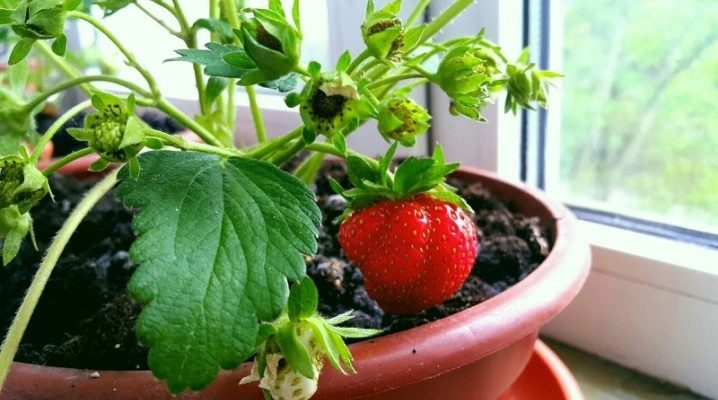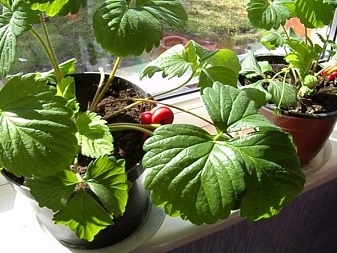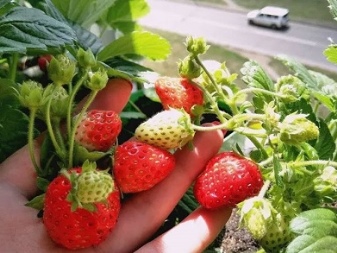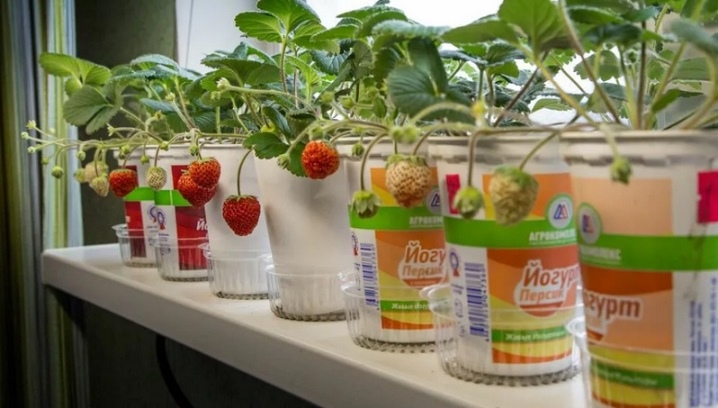How to grow strawberries on a windowsill?

Strawberries belong to crops that are distinguished by a very short fruiting period. It is for this reason that many are trying to master the basics of growing it at home.
Having familiarized yourself with the peculiarities of cultivation, you will understand that it is quite possible to grow this berry even on a windowsill. The result will be large and tasty fruits that you no longer have to buy in stores at huge prices.


Suitable varieties
It should be noted right away that varieties cultivated in a greenhouse are completely unsuitable for home cultivation. The issue of selecting a variety must be carefully considered, since there are a number of features here.
- It is necessary to choose remontant varieties of culture. They will be able to harvest several times.
- The variety should not be too capricious, otherwise you simply cannot provide him with all the necessary conditions.
- The best choice will be specimens of neutral daylight hours. They produce fresh crops almost continuously.
- Ampel varieties are praised by many gardeners. Their peculiarity lies in hanging tendrils, which means that the culture can grow in a suspended state without taking up much space.

The following varieties of strawberries and garden strawberries received the best reviews.
- "Queen Elizabeth II"... A repairing variety that will suit any length of daylight hours. Produces strong and ripe strawberries weighing 50 grams each. Flowering and fruiting last a long period: from the first month of summer to the last month of autumn. Blossoming intervals are 30 days.
- "Supreme"... A wonderful variety that pollinates itself. Fruiting lasts for 9 months, while such strawberries need rest. It runs from February to April. The approximate weight of one berry is 40 grams.
- "Tristan". A very interesting variety that can not only yield a harvest, but also decorate a room. It blooms with bright purple-crimson flowers. In one season, up to hundreds of fruits can form on a bush.
- "Geneva". This is a variety from the USA. The fruit is shaped like a cone, weighing about 50 grams. If planted correctly, it will bear fruit within five years.
- Aisha. The name speaks for itself - this is a variety from Turkey. The berries are large, conical. Bears fruit for a long time, but with interruptions of 14 days. Differs in excellent immunity.
In addition to these varieties, the following varieties are available for home cultivation:
- "Albion";
- "Homemade delicacy";
- "Temptation";
- "Russian Giant";
- Capri;
- "Yoke";
- "Grandian" and many others.


Growing conditions
It should be understood that strawberries and strawberries grown on a windowsill will bear fruit and develop correctly only if they are provided with all the necessary conditions. To grow delicious homemade berries, we recommend using the tips below.


Lighting
Strawberries that are grown on a window all year round need to get enough light. It is best to place pots on windows that face south... This rule is true for winter. In summer, constant scorching rays will only become an obstacle to normal growth. The pots will need to be shaded or moved to the western / eastern windowsills.In addition, already matured plants can be taken out into the courtyard if you live in a private house, or on the balcony, having previously opened the windows there.
In the autumn or winter period, the berries can begin to sour, and this is not surprising, because the daylight hours are gradually decreasing. To keep the harvest sweet, you will have to purchase additional lighting lamps. The best illumination option is fluorescent lamps, but you can also make a choice in favor of phyto-lamps. The devices should be hung about 20 centimeters from the bushes. They are turned on for 8-12 hours.
The work of the lamps is required if it is snowing or raining outside. The total duration of daylight hours for home strawberries is approximately 14 hours.

Temperature
This is another important parameter, without which it is impossible to achieve the proper harvest. The best choice is about 20 degrees Celsius. The maximum that can be allowed in winter is +15 degrees. Lower values threaten the development of all kinds of diseases. If the winter is cold, heaters are recommended in the rooms. Window sills should be insulated and checked for blowing from cracks.
The intense heat is just as painful for the bushes as the cold. If it is more than 30 degrees outside, it is better to take the plants out into the air, where they will at least be blown through.

Humidity
Strawberries grow well and bear fruit at a certain humidity. The correct parameters are from 70 to 80%. If the humidity rises, it will increase the chances of plants contracting any fungal disease. But even lower parameters will have a bad effect on the growth of culture and the formation of ovaries. In both winter and summer, the air can be too dry. If such a phenomenon is observed in the apartment, you need to purchase a humidifier... If it is absent, you can simply spray the bushes with warm, settled water, put containers with liquid next to them, or put wet sphagnum moss.


Choice of capacity
Initially planted strawberries will not require large containers. Seeds are sown in ordinary plastic cups. Then, when the leaves appear, and the plant goes through the picking process, a larger container will be needed. You can choose, for example, flower pots. The minimum volume of such a container is 3 liters, which is enough for 1 bush of homemade strawberries. The pots can be both plastic and ceramic - this does not play a special role.
For those who do not want to suffer by planting each sprout in a separate pot, we can recommend plastic boxes or elongated boxes. It should be noted here that each plant will need the same amount of land - 3 liters... That is why it is necessary to maintain a distance of 20 centimeters between the bushes. Both in pots and in boxes, you will need to organize high-quality drainage. In addition, there must be holes in the container. Make sure they are not clogged with drainage material.
Homemade strawberry varieties are also grown in:
- hanging pots;
- plastic canisters from under the water;
- buckets.

Substrate preparation
Strawberries are quite demanding on the composition of the soil, and therefore it is necessary to choose it as responsibly as possible. For those who are engaged in the cultivation of such a crop for the first time, it is best to contact gardening stores, where they will be helped to choose the right soil. It is mainly a fertile land for flowers and vegetables.
If you are already a professional in this matter, then it is not forbidden to prepare the soil yourself. The soil should be light and loose, allow water and air to pass through. Weak acidity should be chosen. The land should be fertile. The following type of soil will meet these characteristics:
- the land on which coniferous crops grew;
- sand;
- peat.
All three parts must be equal in volume. You can add one piece of leafy earth or peat. They must first be prepared. The substrates are poured into a container, sprayed from a spray bottle, covered and sent to warming up. Besides, it is important to fertilize the prepared soil. Superphosphate is an excellent option. For 3 liters, it is enough to take 1 tablespoon of top dressing.
But summer residents categorically do not recommend using the land from the garden. It may contain fungi and nematodes, and then you will have to deal with a long treatment.... However, sometimes there is no other way out. In this case, the soil will have to be disinfected. The first way is disinfection with potassium permanganate solution... The color of the liquid should be light pink. She will need to spill soil. The second technique is calcination... The earth is placed in the oven for a third of an hour. The latter will need to be turned on 180 degrees.

Landing
Indoor strawberries can be grown in two ways: by seed or ready-made seedlings. The vast majority of gardeners recommend the second method, since the first is difficult. This is a long process, but its features should be known to those who have planned to grow culture in a residential area.

Seeds
It is necessary to prepare the seeds of homemade strawberries in advance. Stratification is a mandatory stage of preparation. A piece of gauze is taken, moistened. Planting material is wrapped in it. The fabric is placed in the refrigerator, preferably in the compartment where the vegetables are. The storage time is 21-28 days. Under the condition of a snowy winter, cheesecloth with grains can be dug into a snowdrift for the same period.
When the required time has expired, you should start preparing the containers. You can use plastic cups or a small box. The container should not be deep. Holes are made at the bottom with a sharp object, then drainage is poured. Crumbled polystyrene will perfectly play its role. The land will not differ from the one in which you plant already grown seedlings. The only thing is that there should be more peat in it. The presence of humus is unacceptable.
The soil will need to be thoroughly tamped, and then watered with high quality. The grains are laid out on the surface of the soil, keeping a distance of a couple of centimeters, and carefully covered with sand on top. To quickly see the result of your labor, the container is covered with glass or a transparent bag, building a mini-greenhouse. The first sprouts will appear if the temperature fluctuates between 18-20 degrees Celsius.
As soon as the seeds germinate, it will be necessary to remove the covering material so that the seedlings quickly become accustomed to the conditions in which they are to grow. It is recommended to sprinkle the soil between the seedlings with a thin layer of sand, which is calcined in the oven in advance. Then the germinated seeds are watered and provided with good lighting. With the appearance of the second sheet, a pick is carried out. If the seedlings are in a box, they are planted in separate containers.
When planting, the roots will need to be straightened, but carefully. It is best to use an awl. After 30 days, the sprouts can be planted in a permanent place.


Saplings
As already noted, this method is the easiest. Seedlings can be grown on their own in the garden, bought at a gardening store or at an exhibition. The main thing is to choose healthy and strong specimens. Gardeners recommend giving preference to seedlings with a closed earthy clod. So the plant will receive less stress during transplantation, which means that there will be less risk of catching any ailment. If the plant is nevertheless with an open root system, then it should be kept in a growth stimulator for some time.
Prepare containers and soil, then it remains only to plant indoor strawberries. The roots, if they are open, are straightened, then the seedling is placed in the hole, sprinkled with soil. Make sure there are no air pockets inside. The root collar is left at ground level. It is impossible to deepen, since this always leads to the death of the bush. A seedling with a closed root system is simply transferred from one container to another, without violating the integrity of the earthen coma. The planted plant is well watered and placed in a lighted place.


Care
Growing strawberries at home is not difficult, but caring for it should be timely. Don't forget about lighting, humidity and air temperature. Compliance with the conditions is the first step to getting a decent harvest. However, the right conditions are not enough. Let's see what else needs to be done.

Watering
Any variety of homemade strawberries has a positive attitude to moisture. The plant should not be allowed to grow in dry soil. But too much liquid will be fatal. Water the strawberries 1-2 times a week to ensure proper growth. To do this, use settled or purchased water without chlorine. The ideal option is rainwater, but not everyone has the opportunity to collect it. The liquid should be at room temperature or slightly warmer.
It is worth mentioning that 1-2 times a week is the recommended amount of waterings under normal conditions. If it is very hot, the land will dry out faster, and more watering will be needed. This must be taken into account, as well as the fact that the liquid is supplied only to the root, and not from above to the whole plant. Watering is best in the evening, but if the weather is cloudy, then watering time does not matter.
In conditions of too much heat or dryness, the leaves are sprayed from a spray bottle, but not in the sun.

Loosening
Despite the fact that strawberries grow at home in very limited containers, the soil will also have to be looked after. It's about loosening. It is mandatory, since the culture prefers light soils, into which air can freely penetrate. For loosening, you can choose a mini garden rake or even a regular fork. The soil is treated a couple of hours after watering, when it is already slightly dry. Be careful as the roots are close to the soil level. Do not immerse the instrument deeper than 2 centimeters.

Fertilizer
Homemade strawberries respond well to all kinds of feedings. Some fertilize it with folk methods, others prefer purchased drugs. Among the folk methods, the following options are especially widespread.
- Nettle... This fertilizer is easy to make in the summer for those who live in the countryside. The weed should be chopped as small as possible and tamped tightly into the jar. Everything is poured to the top with water, covered and sent to a sunny place. After 7 days, the infusion will be ready for use. Immediately before use, it is diluted with liquid in a ratio of 1 to 10.
- Welding... Leftover tea leaves can also be used to feed strawberry bushes. Tea leaves are simply laid out on the soil surface.
- Egg shell. A can of 3 liters is taken, a third is filled with shells, which were previously finely crumbled. One glass of ash is put there. The rest of the space will be occupied by warm water. The solution is left alone for five days, then filtered with gauze. The proportion required for irrigation is 1: 3 (fertilizer and water).
These are the main folk dressings used for strawberries. It is optimal to use them once every 2-3 weeks, but before the berries form. Those who prefer ready-made preparations are advised to purchase mineral complexes in stores. Usually, the packages will say: "For strawberries" or "For strawberries"... These formulations contain everything you need for good growth. Also, homemade strawberries often need iron. When the ovaries appear, you can follow the simplest path - stick a rusted nail into the ground. Or buy fertilizers containing iron.
Important: whatever means are chosen for feeding, they should not contain a lot of nitrogen. Otherwise, you will end up with lush green bushes and sour small berries. It is also worth remembering that the fertile bushes are left alone, not fed.


Pollination
For home cultivation, it is worth buying varieties that can be pollinated on their own. If this is not possible, the owner will have to deal with pollination.This is not difficult: you need to take a small brush and gently go through all the colors in turn. During the flowering period, this should be done at least once every couple of days. However, there is a simpler technique: put a small fan next to it, turn it on for a few minutes and point it at the bushes. The air flow will allow the pollen to be transported.

Disease protection
As in the open field, diseases can attack strawberries. They are mainly fungal in nature. For example, powdery mildew, black leg, gray rot. Such ailments appear due to violation of growing conditions, for example: dense plantings, abundant watering, high humidity. You will have to get rid of them fungicides... Work well Horus, Topaz, Fundazol. You can also use Bordeaux mixture. A diseased plant, if it is in a separate pot, must be quarantined in another room. For mass planting, it is better to remove the most affected specimens from the soil.
In addition to the fungus, spider mites can often be found on home strawberries. The pest comes under the condition of increased dryness of the air. It is not difficult to determine it: all the leaves will be entangled with the finest silvery cobweb. First of all, it is necessary to normalize the conditions in the room. Then treat the bush with acaricides. An infusion of garlic will also help: two large cloves are crushed and placed in a glass of warm water. The infusion will be prepared for two days. Then it will need to be filtered and used for its intended purpose. It can be further diluted with liquid if the concentration seems too strong.


Helpful Tips for Beginners
People who want to grow homemade strawberries in an apartment will definitely benefit from the recommendations below.
- If you do not always remember that plants need watering, it is worth adding a hydrogel to the soil when planting... This substance will contribute to the fact that there is always enough moisture in the soil.
- Home-grown strawberries will require pruning every couple of years. It is necessary to remove the foliage with disinfected scissors, but the growth point cannot be touched. After the procedure, the plants must be fertilized with fertilizing containing nitrogen. Also, if you do not plan to breed, take care of timely cutting off the antennae.
- It is worth remembering that ready-to-pick berries should not hang on the bushes, no matter how beautiful it may be.... In this case, the plant will spend energy on them instead of producing new fruits.
- To prevent plants from getting sick with fungal diseases, you need to provide them with the right growth conditions. Preventive treatment with Fitosporin will also be useful. The procedure is carried out in winter or in July.
Good results will also be obtained by disinfecting the soil with a weak solution of manganese.














The comment was sent successfully.